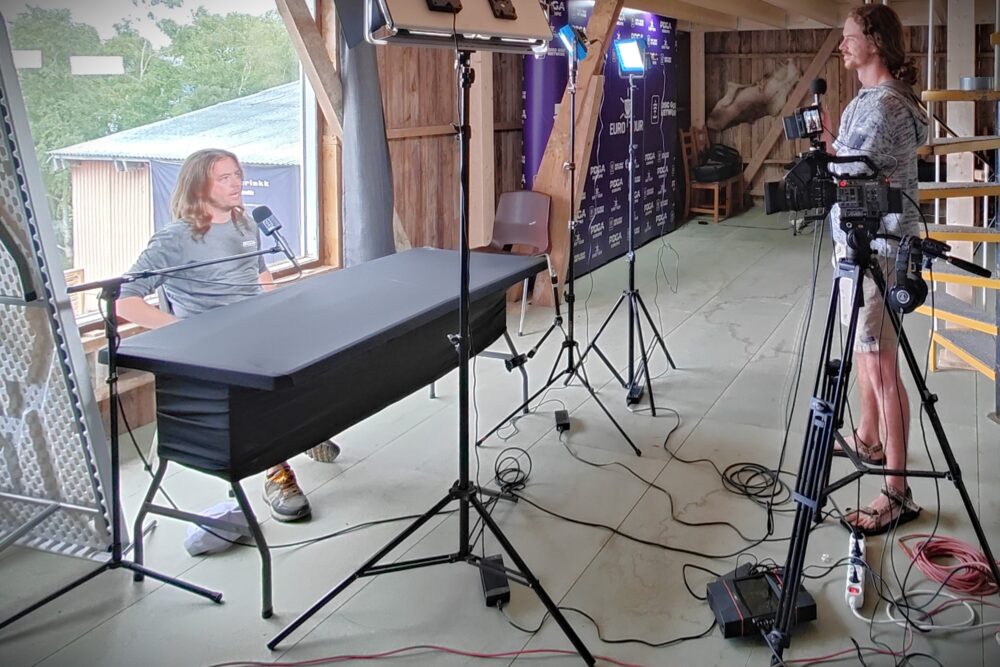Disc Golf may not be a sport immediately familiar to many, but it has a long history dating back as far as the early 1960s. Previously known as frisbee golf, it’s a flying disc sport in which players throw a disc at a target. It uses rules similar to those for golf with the sport usually played on a course with nine or 18 “holes”.
Very popular in the US, it’s also played across Europe and further afield. The US Disc Golf Pro Tour (DGPT) was founded with the primary goal of “creating a stage for the top athletes in our sport to showcase their skills while giving fans an opportunity to socialize and enjoy watching history together as a community.” For 2023, a European equivalent was established by the Professional Disc Golf Association Europe (PDGA Europe), with Pulsea Disc Golf Media, a division of Rockway Oy, handling the media technology implementation to bring the events to viewers wherever they may be.
There were ten broadcasts, remotely produced, from seven countries: Croatia, the Czech Republic, Sweden, Norway, Finland, Estonia and Spain. The biggest challenge in disc golf productions is the location and shape of the courses. The European Open, played in Nokia, Finland, is an exception, because it’s played in the city center, but the courses are mainly located in sparsely populated areas, including forests. Trees, bushes and variations in the terrain play a central role in the sport, but they also cause challenges in terms of producing the events for broadcast or streaming when using traditional methods. Groups of four players move through the course, and, as with golf, it’s easy for a wayward turn to see the disc end up in very tricky terrain from which to film. To provide the dynamic and exciting coverage required, Pulsea turned to the LiveU IP-video EcoSystem, which was acquired through Mediatrade, LiveU’s Finnish partner.
DGPT had already been using LiveU solutions across its productions for the US tour, so system integration was effortless for the two competitions carried out from Europe with DGPT’s own resources. The production capacity was expanded to 12 cameras for the complete European Tour with the addition of Pulsea’s LiveU technology, as bringing the entire system from the US to Europe would have been challenging and expensive. The biggest production was from the European Open played at Nokia, where two simultaneous streams were made with 12 cameras and a newsroom.
Broadcasts were directed from Rockway Oy’s studios in Vallila, Helsinki, where the commentries and remote productions were carried out. The productions used multiple LiveU multi-camera LU800s and related servers. Feeds were sent wirelessly, even from challenging locations and conditions, to Rockway’s studio, using SIM cards from local mobile phone operators. The system also had the option of sending the director’s instructions as talkback directly via LiveU Audio Connect to the camera operators. Camera people could move freely around the courses with the lightweight LiveU units, capturing in detail all the nuances of the games. With the help of additional batteries, it was possible to handle two transmissions a day, which totaled more than seven hours.
The fully produced HD streams were sent to the Disc Golf Network, where viewers could watch the live video via its website or app. At each event, tests were carried out to see if 4K would have been possible and the answer was always “yes”. The delay was kept constantly low and Sony FX6, FX30 and A7 cameras were used. The company operated one of the FX30s with a DJI RS3 gimbal, and the broadcast also used a Mavic Pro 3 drone. The cameras were routed from the receiving LU2000 servers with NDI to Vmix and Tricaster, from where they were mixed for broadcast with graphics and narration.
Using this system enables mobile remote productions from anywhere, as long as the destination has a 4G or 5G mobile phone network. The technological cost savings are considerable when compared to the traditional way of doing the entire production on-site, with these savings increasing when you factor in savings on staff. Of course, this also adds to the sustainability of productions, reducing travel and resources on-site. Without LiveU and this overall workflow, bringing Disc Golf to viewers would be almost impossible in a cost-effective manner.
Creating dynamic, viewer-engaging sports content, content that serves to drive monetization, provides many challenges, especially when factoring in the cost efficiency that’s essential. This project brings together the multiple benefits the LiveU EcoSystem brings, especially when combined with remote production, adding to the portfolio of sports content the company’s solutions are used to create.





